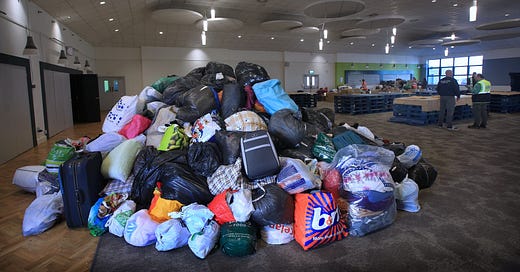How To Donate Clothing In a Crisis
Some volunteers say too much clothing is coming into refugee camps.

On March 14, Charlie Hannerton, a volunteer helping Ukrainian refugees at Poland’s border posted a photo of piles and piles of clothing. Of course, these are donations from people around the world trying to help those who have had to leave their home and their belongings behind as Russia invaded the country. The problem, according to Hannerton, is that the amount of clothing is overwhelming the camps and the volunteers. In a post on Facebook, he showed an enormous heap of clothing, and boxes laying on the street. “When they say no clothes, this is why. This is where clothes end up. Once refugees get to the camps, they then have to get coaches to their next destination in Europe and cannot take bags as there is little space,” he wrote. “This is just a few piles directly outside my tent in Medyka, this is the scene in all camps.”
This is not to say that the donations are wrong or that there is any malicious intent in giving away clothing in a time when people are in need. However, clothing can become burdensome in these situations, and there are ways to approach donations so that they don’t create unintended chaos in the place they land.
Before you donate, be sure that clothing is what is being asked for.
Oftentimes, clothing is a quick and easy donation, one that many of us already have ready to go. Organizations work hard to take these in and ship them around the world, but sometimes it’s not what is actually needed. Even if clothing was an ask last week, it might not be the same this week after thousands answer the call. Make sure you check this before you send your second-hand stuff to see if clothes are still on the list of requests.
If clothing is needed, find out what type you should donate.
Make sure you are sending what is actually requested. In the case of refugee camps in Eastern Europe, that might be items like coats and scarves. Around the globe, disaster areas and refugee camps have had to deal with piles of clothing that isn’t appropriate for the situation – like high heels or athletic wear.
Do not send damaged clothing.
Give money instead if you can.
If you realize that clothing isn’t what’s needed where you want to donate, giving money is better. Make sure you are donating to a trusted organization. Here is a great list.
If you want your used-clothing to make an impact in the future, divide it up.
In the winter, coats can go to a coat drive in your area. Suits and blazers can go to an organization that helps people who need clothing for work. Damaged clothing can be sent to upcycling or recycling instead of clogging up donation bins and ending up in the trash. Instead of sending a giant garbage bag hoping it makes it where it’s supposed to go, be mindful with your donations.



